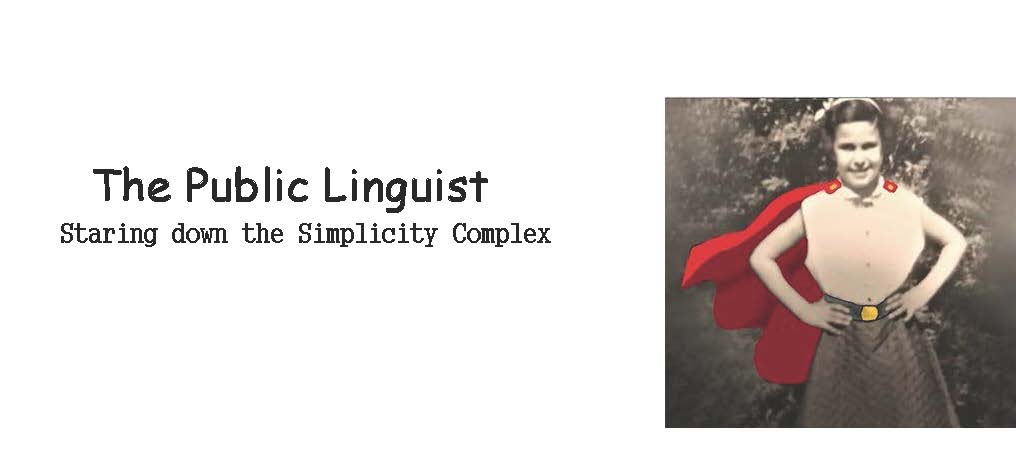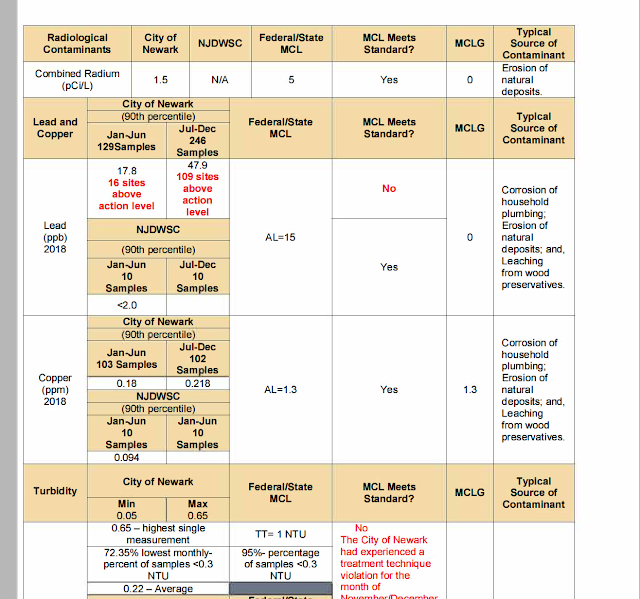When it
comes to informing the public about a toxic exposure like lead in drinking
water, just about every kind of misstep can occur. Officials disguising facts or
offering up alt facts, faulty water contamination tests, dueling experts and
scientific uncertainty and plain and simple incompetence. Maybe there was a time in
the US when we walked around not worrying about how safe our drinking water was,
but that was pre - Flint MI (2015) and now, pre Newark NJ.
Last night with the NJ governor and Newark mayor front and center
at a media event NJ announced that the
city of Newark will receive
a $120 million loan to get poisonous levels of lead out of its drinking
water, and they’d do it in less than 3 years. Once again, from the public
outrage play book, it wasn’t until scared, angry residents + national bad press
combined to get sensible, necessary action.
I’m not qualified and
don’t have the stomach for delving into the underlying mismanagement and incompetence
that inevitably goes into many public health emergency like this one. I
won’t mention that lead levels in Newark’s drinking water are so high that the
New Jersey Department of Environmental Protection issued notices of non-compliance to the city in both June 2017
and January 2018. And I won’t enumerate the ill-conceived, too little – too late, tortured
steps the city took that backfired – home water filters that didn’t work, and a
Lead Service Line Replacement Program that would have taken 8+ years and would cost
each home owner $$. The NYT is doing an excellent deep dive on this.
Instead I will talk about one kind of problem I’ve made my home
for over 40 years - how to communicate often complex health and science to general
publics. The case studies about what works and what doesn’t are legion. In recent history there are Katrina, H1N1,
Ebola, pesticides in food, arsenic in rice, and lead and other toxicants in
drinking water. If pressed to get to the point I’d say there are 3 or 4 things
that perennially go very wrong when official notices about an environmental
hazard are written. That’s what I’ll be talking about. And when I write about
these things, by necessity, I seem to wind up revealing how officials – often popular,
likable, trusted individuals, mysteriously lose all powers to communicate
clearly. Why? And what’s the fix.
Clear Language
The importance of clear communication to inform and help the
public stay safe and healthy is not new. There are many long-standing efforts
by the Federal Gov’t to promote clear communication. The Plain Writing Act (
2010) requires federal agencies to write “clear government communication that
the public can understand and use.”
Federal agencies publish and promote how important it is to use
clear communication. There’s a whole federal website on how to write
plainly so that the largest numbers of people can understand information.
Other federal sites : CDC Clear Communication – Everyday Words For Public Health Communication.
https://www.plainlanguage.gov Plain
language sites even has sample templates writers and designers can use to create
readable, understandable health information.
Newark's Got a Communication Problem
When I looked over Newark’s water quality reports (2017 and 2018),
both with personal introductions from Mayor Baraka, I encountered convoluted
sentences that had little meaning, terms only a scientist or toxicologist would
understand and charts with mind-numbing ppm (parts per million) numbers for
lead levels. I did a health literacy load analysis on the Mayor’s 2018 brochure.
The analysis is simply a process of “unpacking” the writing to identify words,
sentences, & graphics that are “high barrier” – things that will likely
make it hard for readers to understand and use the information (Zarcadoolas,
2006, 2008).
I didn’t have to look far.
3 Things You Don’t Want to Do if You Want to
Communicate Risk Clearly
In both the 2017 and 2018 brochures Mayor Baraka proclaims, (my
highlighting)
“I am pleased to present the Water Quality Report,
which confirms that the City of Newark’s water is
not only safe to use and drink but that it is some of
the best water in the State of New Jersey.
Many of you have heard or read the outrageously
false statements about our water but please know
that the quality of our water meets all federal and
state standards. The only high lead readings were
taken inside of older (pre-1986) one-and-two-family homes that
have
lead pipes leading from the City’s pure water in these structures.”
I’ll leave the assault on truth aside and focus on the 3 communication elements that hobble
the report in terms of its usefulness to the public.
1 Difficult
Words There is basically only one sentence in the report that says there
is a lead problem. But the problem is a very disguised because it uses a very
difficult word. If you don’t know what that word means you lose the
meaning. (again my highlighting)
LEAD:
In the first half of 2017, and the second half of 2018, the City
of Newark experienced a lead exceedance
in its drinking water. Elevated lead levels were particularly found in samples
taken from homes with lead service lines.
“lead exceedance level”
Not the easiest way to say what you really mean –
How about
The amount of lead in the drinking water exceeds (is greater than)
what the Federal Gov’t (EPA) says is safe. We found high levels of lead in water
samples that came from homes that have lead pipe lines.
Also, from a science/civic literacy perspective, if you don’t know
that the federal gov’t sets safe levels of many chemicals, the reference to
levels loses its import.
2 Hard to Read
Sentences
Overly long and complex sentences are another typical problem in
health communications.
a. Where did the
verb go?
A common thing you see in technical or official writing is a
sentence like the following:
In explaining what the city is doing to address the lead level
problem:
“These efforts include: (my underlining)
• Distribution of free filters
and replacement cartridges to qualified Newark residents.
· Implementation of the Lead
Service Line Replacement Program, which will assist property owners with the
replacement of their lead service lines at a reduced cost.
These are what we call “nominalized” verbs – essentially verbs
trying to act like nouns.
Problem is we use the verb to pivot and help us keep who did what
straight in our mind.
Readers have a much easier time reading active sentences, like:
We are distributing free filters…
We are implementing (starting) a Lead Service Line Replacement
Program….
b. Overly complex
sentences
(This from the
Glossary at the end of the Report)
Maximum Contaminant Level Goal (MCLG): The level of a
contaminant in drinking water below which there is no known or expected risk to
health. MCLGs allow for a margin of safety.
Let’s just say that “below which” and “above which” a hard
comparative/relative clause that many readers struggle with.
*Oh, and while we’re at it, generally readers don’t like
glossaries. This is because, unless it’s a hyperlink, they lose
their place going to the glossary and then going back to the text.
3. Numbers and Charts
Why am I always surprised!?
But this type of obfuscated – “Go ahead - just try to understand this chart”- really sets me off.
Why? Because there’s over 30 years of evidence showing that a
significant portion of the US adult population (90 million or more) has
difficulty understanding and using health & science (Rudd, 2002; IOM, 2004;
Zarcadoolas, Pleasant & Greer, 2006). And our ability to work
with numbers (numeracy) is even less impressive (Ancker as an example, as well as Zarcadoolas and Vaughon (2014).
The significant number of charts in the Newark Report use terms
and numbers that have very little meaning to millions of people. Plus the
preface to the charts uses difficult vocabulary, science concepts and complex
sentences. Trifecta!
Bottom line is there are endless reasons for failed public health
& safety communication. Elected officials minimizing and passing the buck,
besieged public works administrators, lack of funds to fix the problem, poor
advice from crisis managers and PR firms, scientists in charge of communicating
to the public, institutional racism and indifference. But far too often
those with the greatest health and social burdens have limited access to
understandable and actionable information. This happened in Newark. It’s shameful. It’s fixable.
I'll let Mayor Baraka close. Quite a commitment to clear communication!
Some references
Zarcadoolas,
C., Pleasant, A. & Greer, D.S. (2006).
Advancing Health Literacy: A frameworkunderstanding
and action. San
Francisco, CA: Jossey-Bass.
Zarcadoolas, C. and Vaughon, W. (2014). If numbers
could speak: low numeracy skills and the digital revolution. In H. Hamilton and
Chou, W- Y. (eds.), Routledge Handbook of Applied Linguistics and
Health Communication, New York, NY, Routledge.
Ancker JS, Kaufman D. Rethinking health numeracy: a multidisciplinary literature review. Journal Of The American Medical Informatics Association: JAMIA. 2007;14(6):713-721.





No comments:
Post a Comment